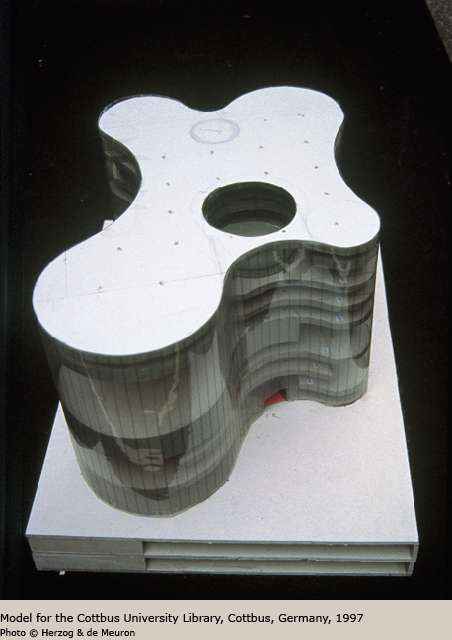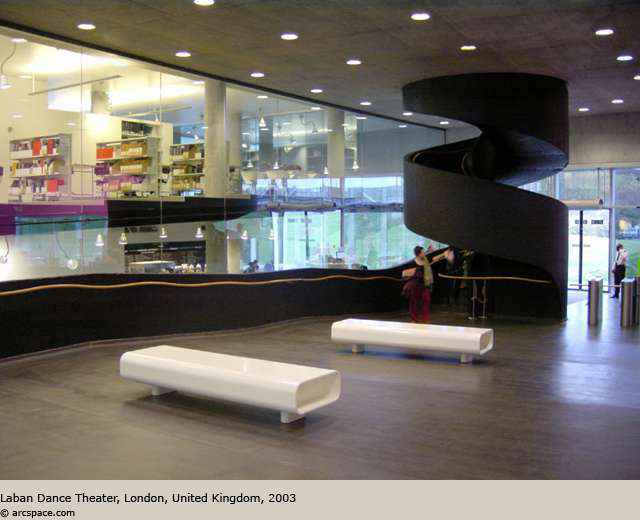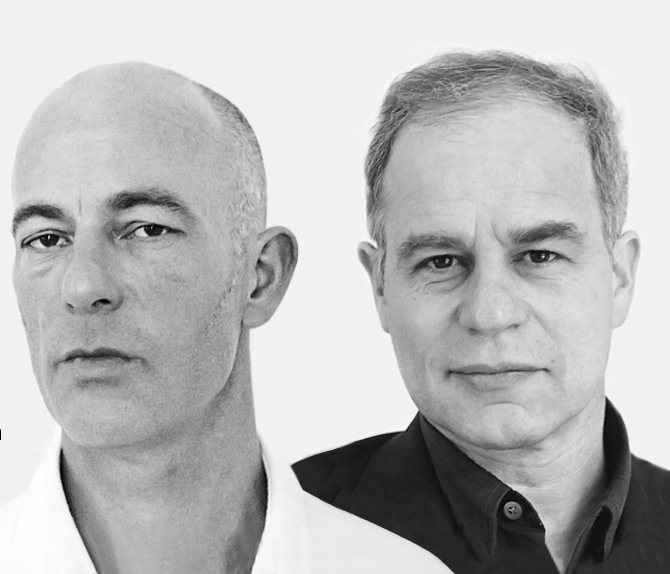
Pritzker Architecture Prize 2001- Pierre de Meuron
“A building is a building. It cannot be read like a book; it doesn’t have any credits, subtitles or labels like
picture in a gallery. In that sense, we are absolutely anti-representational. The strength of our buildings
is the immediate, visceral impact they have on a visitor.” Those are the words of Jacques Herzog
speaking for himself and his partner, Pierre de Meuron, the architects chosen by the jury to receive the
2001 Pritzker Architecture Prize.
Jacques Herzog and Pierre de Meuron were born within a few blocks of each other in Basel, Switzerland
in 1950. They have worked together since the time they were in kindergarten, but when they first met
at the age of seven, they did not speak the same language. Pierre spoke French, and Jacques spoke
Swiss. By the time they finished their secondary education, they had played with Lego and Meccano
toys, building all sorts of Swiss houses, ships and roller coasters, but neither had decided what they
wanted to major in at the university. Herzog first tried commercial design school, but switched to
biology and chemistry at the University of Basel. His artistic interests were still dominant so believing
that architecture was a discipline that would allow him to combine many things, he began studying
architecture at the Lausanne Federal Technical University (ETH). Since de Meuron was good in
mathematics and drawing, he decided on the same course. After their first year there, they transferred
to ETH in Zurich where they remained to complete their degrees in 1975. They both remained there as
assistants to Professor Dolf Schnebli. In 1978, they formed their architectural partnership opening their
office in Basel.
Since then, their careers have been nearly parallel as well. Herzog became a visiting tutor at Cornell
University in Ithaca, New York in 1983. Six years later they both became visiting professors at Harvard
University for a year, then renewed that association again in 1994 to the present. They also are both
professors at ETH Studios in Basel.
Professionally, the Herzog & de Meuron partnership has grown to be an office with over 120 people
worldwide. In addition to their headquarters in Basel, they have offices in London, Munich and San
Francisco. Herzog has explained, “We work in teams, but the teams are not permanent. We rearrange
them as new projects begin. All of the work results from discussions between Pierre and me, as well
as our other partners, Harry Gugger and Christine Binswanger. The work by various teams may involve
many different talents to achieve the best results which is a final product called architecture by Herzog &
de Meuron.”
“Jacques’s strengths are my weaknesses, ”said Pierre de Meuron in discussing their working
relationship,“ and his weaknesses are my strengths. I think I am definitely very good at the middle
phase of a project, while Jacques tends to shine at the beginning and end. And no matter what team
is working on a project, we visit the team every day when things are in the decisive stage.”
They also enjoy collaborations with others, particularly artists, such as Rémy Zaugg, who has been
involved in several of their projects “almost like another partner” to use Herzog’s own words.
In conversations and lectures, some of which have been published, Herzog has elaborated further,
“Andy Warhol is an artist we would most like to have known. He transcended categories. It is too
simple to call him a Pop artist. He used common Pop images to say something new. That is exactly
what we are interested in: to use well known forms and materials in a new way so that they become
alive again. We would love to do a building that would cause people to say, ‘well, this looks like an old
traditional house, but at the same time there is something totally new in it.’”
He continued, “No one has accomplished that in contemporary architecture. Architecture which looks
familiar, which does not urge you to look at it, which is quite normal, but at the same time, it has
another dimension, a dimension of the new, of something unexpected, something questioning, even
disturbing. We love to destroy the clichés of architecture. To do this most effectively, it is sometimes
useful to work with them.”
When asked what have been influences on their architecture, Herzog replied that early in their practice,
their thought about the image was more literal, and he acknowledged influence by others such as
Aalto and Scharoun.”While we were still in school, the late Aldo Rossi (who was a Pritzker Laureate in
1990) was one of our teachers and he opened up many new horizons for us. Prior to his arrival, our first
teacher was Lucius Burckhardt who taught us that whatever we do, we should not build; instead we
should think, we should learn about people. It was inspiring, but it was also frustrating. When Rossi
came, he told us just the opposite. He said to forget sociology, return to architecture. After that we
returned to architectural building with a vengeance. In that regard, Rossi was perhaps our greatest
influence. He interested us in images, but we were never interested in his images. We were never
interested in collecting images of architectural memories.
“When we visited Japan, we were fascinated by the abrupt disjunctions between old and new,
between scales, ” he explained. “Perhaps we like that because it reminded us of our home country.
Switzerland also has very attractive, cozy or harmless architecture next to horrible and brutal half
urban, half rural settlements.”
He continued, “There are no models for us, no paradigms of great architecture that we worship. Rather,
there are moments in buildings—sometimes great, sometimes terrible—that we pay attention to and
learn from.”
And further, “Our work is not based on any tradition, particularly any Swiss tradition. If our work is in
any way Swiss, it is so only in the sense of a country which has no national identity anymore. It has
changed radically from the small, isolated country with a tradition of the Swiss artisan. We believe that
it is today the most modern, technologically advanced country in Europe.”
Rafael Moneo, another Pritzker Laureate who received the prize in 1996, wrote in the Spanish publication,
AV, a monograph on Herzog and de Meuron that their work is “…among the very few architects whose
work can be interpreted as an effort to regain architecture’s original grounds. A search for primariness, for
direct contact with the constructive essence of architecture, characterizes their work and differentiates it
from that of others of their generation, with whom they diverge in their emphasis on originality.”
Moneo further stated, “Herzog and de Meuron have built profusely, demonstrating their capacity
to respond to all kinds of programs with talent, sensitivity, flexibility and efficiency. Their continuous
presence in competitions, and the divulgation of their work in specialized journals, as well as through
their classes in different schools, have made their proposals today a serious option. What is it in their
work that so captivates both students and critics? I would venture to say that, as champions of an
architecture capable of renewing sentiments that all who build are aware of, they conquer those who
resist seeing the world as a haphazard and contingent reality. Even today in their work, the freshness
with which they explore the different uses of materials, and their determination to reduce what can be
understood as an individual expression in architecture to a minimum, remain present.”
Of materials, Herzog has said, “The material world is what we deal with—we try to understand what
matter is. What it means and how we can use it in order to enhance its specific qualities. The methods
we use to print on concrete, for example, are a product of our research. The printing method existed,
but we started to adapt it to and use it for printing photographs on concrete. It is a very interesting,
yet simple process. Chemical treatment in the pattern of the photograph causes the surface of the
concrete to cure at different lengths of time. We are also interested in the mosses and lichens that
grow on the surfaces of stones. They are an indicator of the air quality and their color is spectacular, so
bright—the oranges, the yellows—so beautiful that it almost blinds you.”
Moneo went on to explain that the affirmation: “materials are architecture’s vehicle of expression” is
amply justified in one of Herzog & de Meuron’s projects in the United States, the Dominus Winery in
the Napa Valley of California.
They designed a linear building some 333 feet long, 82 feet wide, and 30 feet high to house three
functional units of the winery—a tank room with huge chrome tanks for the first stage of fermentation,
a barrique cellar where the wine matures in oak vats, and a store room where the wine is bottled,
packed in wooden cases and stored until it is sold. Herzog explained, “In front of the facades, we
placed gabions, i.e. wire containers that are filled with stones. Added to the walls, they form an inert
mass that insulates the rooms against the heat by day and the cold at night. We chose a local basalt
that ranges in color from dark green to black and blends beautifully with the landscape. The gabions
are filled more or less densely as needed so that parts of the walls are very impenetrable while others
allow the passage of some light—natural light coming into the rooms in the daytime, and the artificial
light going out at night. You could describe our use of gabions as a kind of stone wicker work with
varying degrees of transparency, more like skin than traditional masonry.”
Herzog further commented, “We arrive at solutions like this through our research which I categorize
as being in two areas: the first being what life is today, meaning art, music, and other contemporary
media activities; and the second is what techniques we can discover or invent to bring architecture to
life, meaning in this case, technology, the inventions that enable us to realize our architectural vision.”
One of their unique solutions for a project was the six-story building on the edge of the railway tracks
next to a new railway engine depot (also designed by Herzog & de Meuron) and the walls of 18th–19th
century cemetery. The building, called Signal Box, houses mainly electronic equipment for the control
of points and signals to the related depot and tracks, as well as a few work stations. The building’s
concrete shell is wrapped horizontally with 20 cm (a little less than 8”) wide copper strips that are
gradually twisted at certain places in order to admit daylight. The twisted bands also cast shadows on
the façade. The copper coiling also acts as a Faraday cage protecting the electronic equipment inside
from unexpected external effects.
But perhaps their highest profile project is the recently opened Tate Modern, the former Bankside
Power Station nearly opposite St. Paul’s Cathedral across the Thames River in London. Speaking
of the project, Herzog and de Meuron stated, “It is exciting for us to deal with existing structures
because the attendant constraints demand a very different kind of creative energy. In the future,
this will be an increasingly important issue in European cities. You cannot always start from scratch.
We think this is the challenge of the Tate Modern as a hybrid of tradition, Art Deco and super
modernism: it is a contemporary building, a building for everybody, a building of the 21st century.
And when you don’t start from scratch, you need specific architectural strategies that are not
primarily motivated by taste or stylistic preferences. Such preferences tend to exclude rather than
include something. Our strategy was to accept the physical power of Bankside’s massive mountainlike
brick building and to even enhance it rather than breaking it or trying to diminish it. This is a kind
of Aikido strategy where you use your enemy’s energy for your own purposes. Instead of fighting
it, you take all the energy and shape it in unexpected and new ways.” The critical acclaim has been
nearly universal.
They have a number of other museum projects either under way or completed, including the M. H. de
Young Museum in San Francisco; the Oscar Dominguez Museum and Cultural Center in Tenerife; an
extension to the Walker Art Center in Minneapolis; as well as an unrealized plan for the Museum of
Modern Art in New York.
Their first exhibition space was a house for an art collector in Therwil, Switzerland in 1985. The house
description is as follows from El Croquis: “The house’s site is part of a suburb of small plots; its basically
rectangular outline rises from the street to a meadow that is as yet undeveloped. The visible volume
of the house, a single story parallel piped of precast concrete panels held in place by pine slats with
a double pitched roof of black concrete tiles, rests on a perimeter reinforced concrete wall. The latter
is part of an enclosure that defines both the lower entry court as well as the upper grassed garden.
Contained within the base are a garage and an exhibition space.”
One of their latest projects is the house for the Kramlichs in the same Napa Valley of California where
the Dominus Winery is located. This is a home for a video art collecting couple. The project promises
to be an exciting experiment in using the domestic scale as a media facility.
The Goetz Art Gallery in Munich, Germany is a free-standing volume in a park-like garden. It comprises
a timber configuration resting on a reinforced concrete base of the same dimensions that is half buried
so that only its upper glazed perimeter is visible from the outside. A similar matt glass strip surrounds
the timber volume at the upper most section, admitting diffuse glare free daylight from a height of four
metres (approximately 13 feet) into the exhibition spaces.
One of the houses referred to in the jury citation is the Rudin House in Leymen, Ht. Rhine, France which
was completed in 1997. The description by Herzog and de Meuron is as follows: “The exterior shape of the
house might be seen as heavy and archetypal volume, that seems to be suspended above the gentle
slope, demonstrating its desire to be perceived as an abstract object. A sloping roof, a tall chimney and
large windows remind one of child’s drawing. The tar-board roof and the unfinished concrete facades
flow almost seamlessly into one another without an overhang. The simple monolithic building is exposed
to wind and weather; rain water runs down it as it would run down a boulder. The unfinished concrete
walls of the facades emphasize the weight and materiality of the building, but being raised off the
ground as if on stilts lightens its appearance. The projecting platform, that extends the floating base of the
house in an east-west direction and stretches the interior rooms over a film of water on one side and a
terrace lacking a parapet on the other, reinforces this image of lightness, and of suspension over the
landscape. Fruit trees and meadows underline the agricultural character of the garden that is barely
distinguishable from the surrounding landscape. The compact, abstract image of the house is supported
in a material definition that makes the roof chromatically akin to the walls. A clean edge neatly resolves
the interface between the concrete walls and the bituminous film that resolves the sloping surfaces.
Reduced to its minimum expression, the guttering is replaced by a metal drip strip that guides the
rain water to the edges of the west façade, at the foot of which is a pond.”
Their very first house is called the Blue House for its skin of powdery blue paint that has a transparent
shimmer which has the feeling of lifting the house out of the earth tones of its surroundings. A few
years later, in Tavole, Italy, they did a three-story residential building on the mountainside. It has a cruciform
concrete skeleton filled in with undressed stones, hence the name by which it is known, Stone House.
Just three years later, in Basel, they designed a Plywood House, which makes extensive use of plywood
both inside and outside.
In a conversation with Jeffrey Kipnis for El Croquis, Herzog said, “We think, and of course we hope that
our work at least tries to appeal to life, and to liveliness, it appeals to the five senses. There are critics who
look at our work and only see tasteful facades and Cartesian form and call it conservative. That is
something we cannot understand! These are stale judgments. They think in conservative categories, such
as: square is boring, or solidity is old fashioned. With such a way of thinking you cannot have access to our
architecture, which avoids entertainment and spectacular gestures. At the limit, we believe that
architecture should merge more with life, to merge the artificial and natural, the mechanical and biological.”









